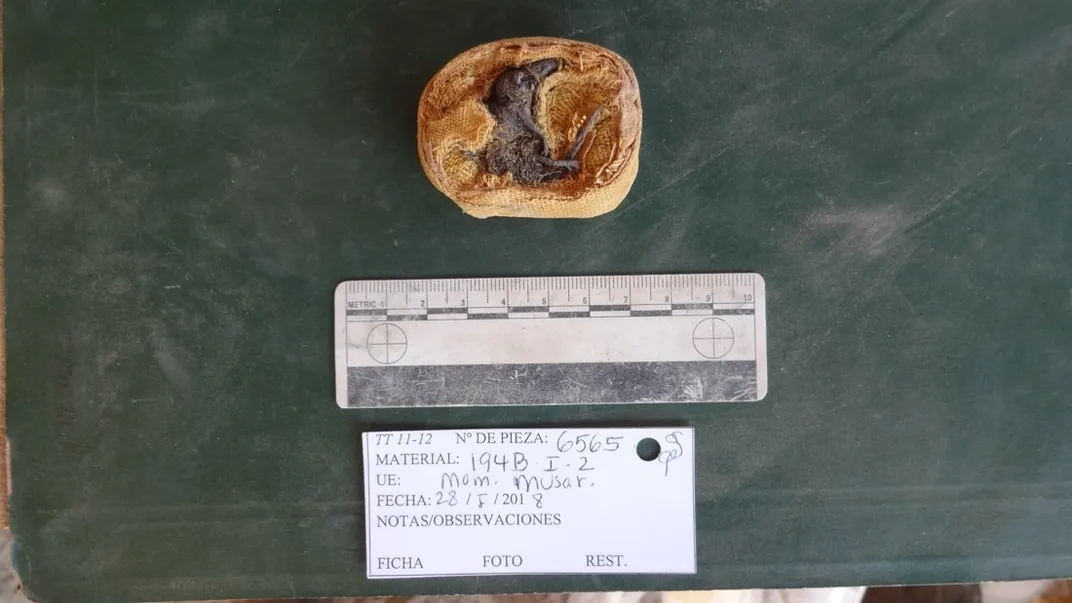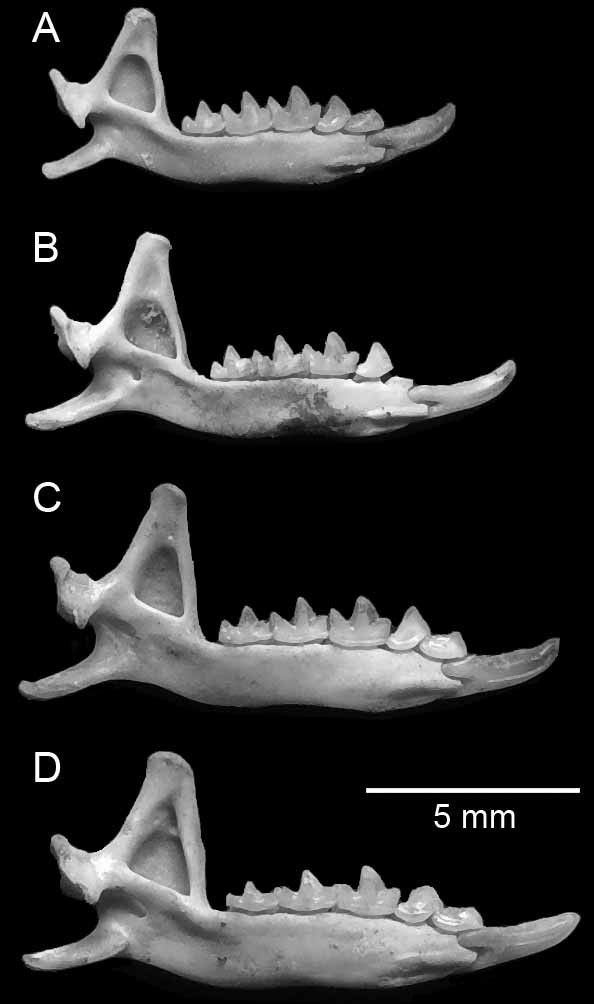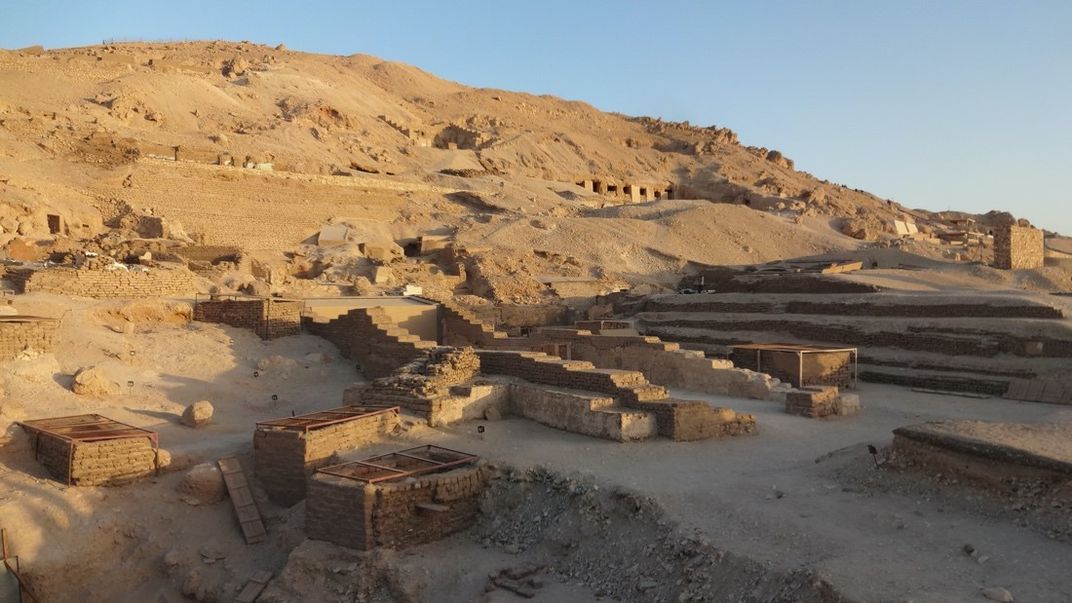NATIONAL MUSEUM OF NATURAL HISTORY
Mummified Shrew Discovery Unearths Ancient Egypt’s Wetter Climate
A mummified shrew found at Quesna suggests that ancient Egypt’s environment was once more wet than it is now.
/https://tf-cmsv2-smithsonianmag-media.s3.amazonaws.com/blogging/featured/Four_people_excavating_in_an_Egyptian_dessert.jpg)
Within the Nile Delta, the ancient Egyptian burial area at Quesna, is a hotspot for archaeological research. The location, protected by Egypt’s Ministry of Tourism and Antiquities, has been enticing researchers for decades.
But the remains at one of Quesna’s burial sites, the large Falcon Necropolis, are not human. Its corridors store many creatures like falcons and shrews interred for religious reasons over 2000 years ago. Scientists study these animals to uncover information about ancient Egypt’s biodiversity and environment.
“A lot of these animals don’t exist in Egypt anymore, so the mummies can show us how environmental change has affected animals that once lived there,” said Neal Woodman, a United States Geological Survey scientist and research associate at the Smithsonian’s National Museum of Natural History.
Recently, Woodman and his colleagues discovered a mummified shrew belonging to a species that prefers a damper climate than the one Egypt has today at the Quesna site. Their finding, published in the journal PLOS One, suggests that ancient Egypt’s environment was once more wet than it is now.
“Because we know where this species is found in modern times and what environments it likes, we can extrapolate what environment it would have flourished in back then,” said Salima Ikram, research associate at the museum, archeologist at the American University in Cairo and co-author on the paper.
The species, called Güldenstaedt's White-toothed Shrew, not only helps to show how ancient Egypt’s environment once looked. Its presence in the Falcon Necropolis adds to scientists’ understanding of how the region’s animal diversity changed over time.
A shrew’d practice of worship

During the Late Period and Ptolemaic Periods roughly 2500 to 2000 years ago, ancient Egypt experienced a rise in animal cults, which used different symbolic animals as offerings to ancient Egyptian gods. At the Falcon Necropolis, cults offered animals to worship a special manifestation of the god Horus.
Some of these animals, like falcons, are so abundant that scientists suspect they were mass-farmed in large numbers for sacrifice. Others, like shrews, are less common.
“We don’t have the high numbers for shrews as we do for other species. It was probably easier to trap shrews rather than try and breed them. They're quite tricky to breed and very nervous,” said Ikram.
If ancient Egyptians were trapping locally available shrews for mummification, it suggests that shrew remains in the Necropolis represent what species were native to the environment at the time.
Fragmentary research

Much like their human counterparts, mummified shrews come in different conditions, ranging from the rare, whole mummy to preserved bone fragments.
“We mostly work with shrew remains that were mummified but whose wrappings rotted or were destroyed,” said Woodman. “They can be easily studied because their bones are free.”
To determine a mummified shrew’s species, Woodman relies on physical characteristics like bone size, length and shape. For example, the mummified shrew found in the Falcon Necropolis has a jawbone slightly larger than two of its relatives at the site.
"We can distinguish what species a specimen is based on its size because all shrew species at this site tend to be slightly different sizes,” said Woodman.
He and his colleagues’ discovery of the mummified Güldenstaedt's White-toothed shrew adds to scientists’ understanding of climate in the region over 2000 years ago.
“This all lets us find out more about the breadth of species that we’ve got, which helps us to think about the wider environment of the time and the types of creatures it could support,” said Joanne Rowland, an archaeologist at the University of Edinburgh, co-author on the paper and director of the fieldwork in the Falcon Necropolis at Quesna.
Charting the way forward

For a while, scientists have been studying fluctuations in ancient Egypt’s climate, reconstructing environmental change. The appearance of this mummified shrew as well as other animals at Quesna supports the theory that 2000 years ago this region was moister than it is today.
“The results of our research, including sedimentary coring around the site of Quesna, also help us think about what that natural environment used to be at given points in time,” said Rowland. “We can reconstruct the proximity of the local river branch, for example, as well as considering the diversity of the animal population.”
But finding a mummified shrew from a species that prefers less arid environments not only confirms existing knowledge about ancient Egypt’s climate. It could also show how environmental fluctuation over the last two millennia influenced regional animal diversity.
“We are uncovering how the animal community was changing. And there’s a cascading effect ecologically when you lose little things that no one usually cares about,” said Woodman.
Moving forward, Woodman hopes to continue using mummified animal remains to chart how species relationships transformed as Egypt became drier.
“What I really want is to examine a bunch of sites so we can start identifying patterns of diversity throughout the entire area,” said Woodman. “This for me is just the beginning.”
Related Stories:
Bison Mummies Help Scientists Ruminate on Ancient Climate
What A 1000-Year-Old Seal Skull Can Say About Climate Change
Viper’s DNA Reveals Ancient Map of South America
New Study Pushes Origins of Human-Driven Global Change Back Thousands of Years

